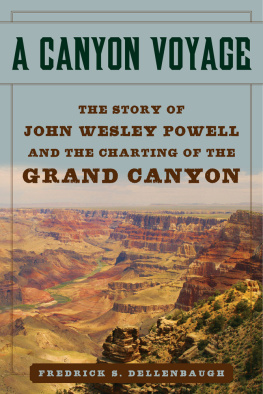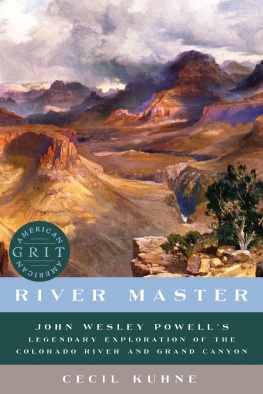Copyright 2018 by John F. Ross
Penguin supports copyright. Copyright fuels creativity, encourages diverse voices, promotes free speech, and creates a vibrant culture. Thank you for buying an authorized edition of this book and for complying with copyright laws by not reproducing, scanning, or distributing any part of it in any form without permission. You are supporting writers and allowing Penguin to continue to publish books for every reader.
Map illustrations by Jeffrey L. Ward
Acknowledgments
No single experience put me closer to John Wesley Powell than a raft and dory trip down the Colorado River through the Grand Canyon. Im indebted to the Arizona Raft Adventure river guides, who did so much more than conduct my family and me safely down the river. Second-generation river guide Bruce Quayle not only shared his stories of the river in 1983, meeting Ed Abbey, and how to negotiate immense standing waves, but also read from his father Amils cowboy poetry. Tater, the Invincible Dachshund tells the hilarious, but trenchant life of a dog that gets half eaten by coyotes, run over by a Datsun pickup, chewed up by German shepherds, and stolen by Mexican bandits, yet still manages to survive and does so cheerfully. Could be a parable for writing books, if not living ones life. Thank you to trip leader Derik Spice, and guides Aaron Cavagnolo, Larry Vermeern, Phil Sgamma, and Natalie Zollinger for sharing their personal journeys, insights about life on the river, and theories about Powells 1869 river expedition. And a warm thanks to Ann Crittenden for setting up the trip. Experiencing the Grand Canyon, especially on the river itself, is a giftand the guides are the purveyors of the stories that keep alive the history of the Grand Canyon and its great river, tales of fortitude and exploration, of geology and the extraordinary richness of Native American cultures, of the Kolb brothers, and the eccentricities of Georgie White. Thanks to all my paddling buddies with whom Ive shared enjoyable river time in the Canadian Arctic and Siberia, on the Yak, the Potomac, and Kennebec.
One of the great joys of writing a book is engaging with passionate scholars and independent historians. The topic of John Wesley Powell has spawned a particularly robustand opinionated!group. Among them are the inveterate river rats who have meticulously traced Powells river trips and seize every opportunity they can to grab a paddle and get wet, the geologists who have examined the rock strata along the Green and Colorado, the boat builders who have re-created Powells rowboats from scratch, and the historians who have spent years digging for clues and theorizing about Powell and the expedition members on that famous trip just about 150 years ago. This book draws on their work and taps into their passion for history and discovery. I thank Wayne Ranney, Richard Quarteroli, Brad Dimock, Earle Spammer, and Michael Ghiglieri for generously sharing their insights. Don Lago, who has done quality work sleuthing Powells documents that relate to the 1869 river trip and has offered multiple fascinating theories, never failed to respond thoughtfully to my myriad questions. I would particularly like to thank Ray Sumner, a descendent of Jack Sumner, who opened up so many new doors for me with his assiduous research and penetrating questions. His enthusiasm reminds me of why I write history.
This book would not have been possible without the fine work of dozens upon dozens of archivists, librarians, and historians, only a few of them that I can personally thank here. They include Lizeth Zepeda, the Arizona Historical Society; Stephen J. Pyne, Arizona State University; Scott House, Cape Girardeau, MO; John F. Underwood, Christ United Methodist Church, Jackson, OH; Sarah Gilmor, Stephen H. Hart Library & Research Center, History Colorado; Kevin Cummings and Jeremy Tiemann, Illinois Natural History Survey; April Karlene Anderson, Dr. Jo Ann Rayfield Archives, Illinois State University; Meg Miner and Tony Heaton, the Ames Library, Illinois Wesleyan University; Mike Stroth, Jackson (OH) Historical Society; Cynthia Nelson, Kenosha History Center; William Kemp, McLean County (Illinois) Museum of History; Louisa Hoffman, Oberlin College Archives; Scott Tutti Jackson, Ohio History Connection; Carol Holliger, Archives of Ohio United Methodism, Ohio Wesleyan University; Heather Henson, Shiloh National Military Park; Marc Rothenberg and Kathy Dorman, The Joseph Henry Papers, Smithsonian; Tad Bennicoff, Mary Markey, Heidi Stover, Smithsonian Institution Archives; William Fitzhugh, Senior Scientist, National Museum of Natural History; Art Molella, Lemelson Center for the Study of Invention and Innovation, Smithsonian; Mark Shenise, General Commission on Archives and History, the United Methodist Church; Gregory M. Walz, Research Center of the Utah State Archives & Utah State History; David Slay, Vicksburg National Military Park; Ann Wake, The Wake Kendall Group; Lee Grady, Wisconsin Historical Society; Terry Hogg; and Justin Solonick.
I would also like to thank the descendants of Emma Powell, William and Wendy Crag, who generously shared their portrait of Emma with me. Thanks to the always engaging members of the Literary Society of Washington, which Powell himself once belonged to, who were always ready to challenge me and support this project. And thanks to the history committee of the Cosmos Club for their committed effort to celebrate Powells work and encourage mine.
I extend my deep thanks and appreciation for those who read all or parts of my manuscript: Sam Holt, Joseph Meany, Albert J. Beveridge III, Donald Ritchey, Kirk Johnson, Richard Quarteroli, Wayne Ranney, and Peter Cozzens. A special thanks goes to my researcher, the incomparable Marcia Thomas, who steered me through the maze of Powells primary material and historiography with particular deftness. Her ability to wrest obscure documents from institutions was exceeded only by her sage guidance when my interpretations veered too close to the edge. Her good cheer was always a tonic. Any mistakes Ive made, of course, are all mine.
I extend my deep gratitude to Timothy Dickinson, to whom this book is dedicated. Our frequent spirited conversations and debates at the Lisner-Louise-Dickson-Hurt Home in Friendship Heights, Washington, D.C., resulted in an abundance of important insights about Powell and his times. Over the years, no one has taught me more about the beauty and the extraordinary precision of the English language. I am deeply honored to call him my friend.
To my editor at Viking, Wendy Wolf, I take a deep bow. Her enthusiasm about this project, her excellent editing, rapier wit, and sound judgment, made this a far better bookand a more enjoyable experience along the way. And the editorial suggestions made by her assistant editor Georgia Bodnar on the manuscript hit the mark. And thanks to Terezia Cicel, who has carefully and patiently guided the book process, designer Nancy Resnick, cartographer Jeffrey Ward, indexer Stephen Callahan, production editor Eric Wechter, managing editors Tricia Conley and Tess Espinoza, jacket designer Elizabeth Yaffe, and senior publicist Tony Forde.












